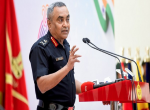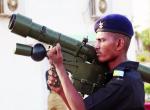Ever since we became independent we seem to be lurching from one crisis to another in any matter which concerns a deal or a transaction in which we make purchases or where decisions are taken regarding business. One harks back to the scandal attributed to the purchase of jeeps when Krishna Menon was High Commissioner in London. The most celebrated scandal in this behalf was the purchase of 155 mm guns from Bofors, a Swedish arms manufacturer renowned internationally for the quality of the product produced by the company. The Bofors anti aircraft gun of 40 mm, the Bofors quick firing gun version mounted on small naval vessels were the mainstays of most of the Allied Forces and even today the Bofors anti aircraft guns are widely used. The 155 mm gun is of such a superb quality that it could virtually dominate the Kargil battlefields and was a major factor in our being able to dislodge the Pakistanis. However, the purchase agreement was befouled by allegations of bribes being given by the suppliers through an Italian agent, in which the name of Rajiv Gandhi was also mentioned by V.P. Singh. The amount of bribe was Rs. 64 crores. Rajiv Gandhi denied any wrongdoing, V.P. Singh never produced any evidence which could have clinched the matter, CBI utterly failed to unearth irrefutable evidence and Quattrochi, the Italian agent, could never be brought to book. What resulted was that we virtually black-listed Bofors and every effort to purchase more guns to strengthen the artillery has been aborted by allegations of corruption, leading to blacklisting of almost all the manufacturers of a gun of this calibre and quality. The tragedy is that Bofors, despite all the mud slung at them, completed its part of the transfer of technology by making available very detailed drawings of the gun. These lay gathering dust in the Defence Ministry, despite the fact that the Ordnance Factory Board kept telling government that it could manufacture the gun on the basis of these drawings. Manufacture could have started at least eight years ago and by now the indigenous gun could have been in service with the Army. One allegation of corruption, which never led to any viable action against the persons named as the culprits, has left the Indian Army in the unenviable position of not having added a single worthwhile gun in over twenty years.
The acquisition by purchase or indigenous manufacture of warships upto the destroyer class by the Navy has had a relatively better record than weapon acquisition by the Army or the Air Force, but in terms of under water capacity the Navy has not advanced at all, whether it be the French Scorpene submarine or the German HDW. The Navy has been able to make very little progress because we just do not take any decisions in order to avoid complaints. Despite this there are serious allegations of financial irregularities. By now we should have had at least fifty submarines, including at least four or five nuclear submarines, but all we have managed is one nuclear submarine on lease from Russia and one indigenously manufactured nuclear submarine whose sea trials have yet to be conducted. Our lone aircraft carrier is now obsolete and its replacement, INS Vikramaditya (formerly Admiral Gorshkov), has had a 250 percent increase in cost and will not be delivered till the end of 2013, five years behind schedule. The keel of the indigenous aircraft has been laid but it is unlikely to be in service till 2017. Meanwhile China has acquired and put into service one aircraft carrier bought from Ukraine and is in the process of manufacturing one more carrier. Without a strong submarine fleet equipped to fire nuclear tipped missiles we cannot really boast of having a sea-land-air based nuclear deterrent in place. Those who are responsible for decision making must realise that in an environment in which our two chief opponents, Pakistan and China, have nuclear weapons and some delivery systems to target Indian cities, our delaying of decisions of purchasing or manufacturing necessary defence equipment has left the nation precariously vulnerable.
The cause celebre is a relatively minor acquisition of twelve helicopters for carriage of VVIPs. The proposal has been mooted by the Air Force about fifteen years ago because the MI8 helicopters on VIP duty are now totally obsolete, difficult to keep airborne and really not in a position to safely carry dignitaries such as the President and the Prime Minister. It was initially mandated that the new VIP helicopters would have an operational ceiling of 18,000 feet and the specifications were drawn up accordingly. Only one helicopter, the Eurocopter 200, could attain this height and this narrowed down the purchase to a single vendor. The then National Security Adviser, Brajesh Mishra, pointed out the unacceptability of a single vendor. The SPG, which guards the Prime Minister, also objected to the cabin size and said that it would not be in a position to protect the VIP unless the cabin specifications were changed. Therefore, the NSA recommended that the matter be re-examined. The file was shunted back and forth for at least five more years. Ultimately the Air Force recommended new specifications, lowering the ceiling to 15,000 feet and also stating the size and the layout of the main cabin. Now four firms give their tenders. Had the specifications not been changed the order was not large enough for any firm to change the aircraft design and also restructure the production line as this would be uneconomical. Therefore, there was no alternative but to change the specifications. It is now alleged that bribes were paid to the cousins of the Chief of Air Staff and, therefore, there was the suspicion that the specifications were altered to suit one company only, Finmeccanica, which manufacturers the Agusta Westland helicopter. The amount of bribe is stated to be in excess of Rs. 360 crores.
The above allegation is based on the statement said to have been made by two officials of Finmeccanica who were arrested in Italy on a complaint alleging corruption in the Indian transaction. No one has said that the process whereby the Agusta Westland helicopter was finally selected was in any way wrong. It is not alleged that technically and financially the best bid was not that of Finmeccanica and Russian and American (Sikorski) bids were wrongly rejected. The adherence to prescribed norms of the Agusta Westland helicopter has not been questioned, nor has its performance. It has also not been alleged that had the bribe not been paid the helicopter would be cheaper to that extent. Had this been stated then it would have meant that we were being overcharged in order to pay a bribe.
What has been the Indian reaction? The media, print and electronic, have virtually gone berserk in sniffing out and unearthing wrongdoing in the instant case. Television anchors wave papers on the screen and state that these give proof positive of wrongdoing in the helicopter deal. From this these anchors deduce that other deals not connected with this particular purchase also are suspect, that bribes have been given and that either because the same agent figured in more than one case, or because the supplying company was the same, every defence deal is based on corruption. What is written in those papers is never shown, nor is it categorically stated that they constitute the totality of documentation, nor is their any real attempt to prove that the so-called papers, which form part of a larger whole, are being read in context. Selective display of documents or use of words can be very dangerous. One recalls the story of the Giant Panda who walked into a restaurant in New York finished his meal, took out a revolver, shot dead the restaurant owner and left without paying for the food. When arrested he said, “Have you not read what we Pandas do? A Panda eats, shoots, and leaves”. Delete the commas and this would read “A Panda eats shoots and leaves”. Our Indian scribes, unfortunately, believe in retaining the commas in the above sentence, which not only changes the meaning of the context but also leads to very dangerous conclusions. There is no need to be judgemental about an issue because some television anchor waves papers in the air, pontificates holily about the evidence of wrongdoing that he has and then tries to browbeat people into saying ‘mea culpa’. If there is wrongdoing let it be investigated and the accused brought to trial. That trial will be in a court of law, not in a court of journalism.
To return to the helicopter purchase case, the need for new helicopters is amply proven and requires no clarification or elaboration. Changing of specifications, which would be universal and not confined to benefiting a particular manufacturer, is not only permitted but is normal. If the tender procedure is transparent, if bids are duly received and are examined impartially, if the product is what we need, if the price is acceptable, then the deal is complete and must be given effect to. If there are allegations that despite precautions bribes have been given, let the complaint be investigated and if a prima facie case is made out, then the accused persons must be brought to trial. However, the acquisition should be completed because it does not make sense to foreclose on a deal which is beneficial to India.
The Indian Air Force has been trying desperately to find a multi-role combat aircraft. The process of specifying norms, performance parameters, etc., has been long drawn out and the Air Force has virtually tested every alternative almost to destruction. Optimising the performance index of the aircraft, its lift and delivery capacity in the matter of weapons, the transfer of technology and the possibility of future total indigenisation, the maintenance schedule and cost, as also the operational life of the aircraft, the Air Force found the Dassault Rafale aircraft to be best suited to our needs. The American F16 and F18, The Anglo German Eurofighter and the Russian MIG-35 did not come up to the mark and were rejected. The technical and financial bids were taken into consideration when making a final selection. Over a year has passed and we have still not signed the final agreement. Meanwhile our television channels have tried to find a connection between a person who sued the Dassault Corporation over some deal for Mirage 2000 aircraft dating back to about eight to ten year. That gentleman sued the Dassault Corporation because he said he had not been paid an amount which had been promised to him by way of commission. My information is that he lost the case. Now an effort is being made to try and show that he is involved in the Rafale deal also so that even this acquisition is aborted. Are only television channels honest in this country and every one else is rotten to the core?
The process by which we arrive at conclusions is bizarre. There is a perception which we can ignore only at peril that Indian officialdom is corrupt. Let me narrate an incident dating back to 1968, when I was Director, Tribal and Harijan Welfare in Madhya Pradesh. One day my minister summoned me to the Secretariat, about ten kilometers from my office. When I entered his room I found a gentleman sitting there. The minister said that he had some problem and could I sort it out? I took the gentleman to my office where I would attend his case. I had not brought my driver and was driving the official vehicle myself. When we reached the Hamidia Hospital gate the gentleman asked me to stop. I asked him why and he said that we should have a cup of tea and some snacks before proceeding further. I told him that I would give him a cup of tea in my office but I found him still a little uneasy. Suddenly it stuck me what the man must be thinking. I was a sahib because the minister had offered me a chair. At the same time I was driving my own car and there was no attendant with me. This meant that I could not be the bada sahib who naturally would have travelled in style with paraphernalia. Therefore, unless the applicant entertained me I would not give him a proper hearing. This is what people felt about the bureaucracy even in 1968, when actually the bureaucracy was by and large honest and efficient. Today the position is that every single person is convinced that government and its minions are corrupt, despite the fact that there is a substantial number of people who are honest. The tragedy is that this perception of dishonesty is what our media is exploiting to blow things out of proportion.
Let us take the helicopter purchase case. If the aircraft is good let us buy it, but if bribes have been given let us deduct that amount from the payment to be made to Finmeccanica and also impose an equivalent fine. The aircraft acquisition, however, should go on and government out of panic should not negate the entire effort by cancelling the order. Let us have a similar attitude towards all defence requirements, which must be finalised unless there is incontrovertible proof of corruption. Waving sheets of paper before a television audience does not constitute such proof.
General N.C. Vij, former Chief of Army Staff, once told me that the process of weapon acquisition is so tortuous in India that by the time the weapon is received its half life is over. The following time frame for weapon purchase is suggested:-
- The Service Headquarters submits a proposal to government for acquisition of a certain weapon system, together with full justification, the cost estimate and tentative specification parameters. The process of preparing this proposal should not exceed one year.
- Examination of the proposal by government and a decision on the acquisition in principle, with a provisional budgetary allocation. The period for this should not exceed six months.
- Detailed specifications to be finalised by the Service Headquarters, acquisition of prototypes and the testing to destruction under different physical and weather conditions. This process should be completed within two years
- Stage two technical and administrative estimates and proposals to be submitted by the Service Headquarters to government. The process of decision making in this behalf must be completed within six months.
- Preparation of tender documents, issue of notice inviting tenders, receipt of tenders and the preparation of a comparative chart by the Service Headquarters, assisted by the Defence Ministry, together with short-listing of providers. This process should not take more six months.
- Examination of the scrutinised bids and the comparative statement, the short-listed providers of the systems and a final decision on acceptance of the bid by government. This should not take more than six months.
- Finalisation of whatever documentation is needed for the contract and issue of the work order. This should not exceed six months.
If the above scheduled is followed, then within six years from the proposal having been mooted the inflow of equipment concerned should begin and the whole process should be completed within seven to eight years from start to finish. If this happens our acquisition process would be within the given time frame, there would be no delays and because the process is continuous, the need or the possibility of giving bribes would be substantially reduced. Then people would be encouraged do business with India.
Let us take this whole issue very seriously because if the present trend continues we might as well disarm and disband the armed forces, deploy village kotwals or chowkidars armed with lathis to guard us and practise how to behave like slaves before the new conquerors who would inevitably make us captive. To obviate such an eventuality we need a government which is firm in its resolve and which refuses to be swayed merely because some complaints have been made, we need a machinery for quick investigation of complaints, but we also need a media which is responsible in its behaviour, exercises restraint where it is necessary in our national interest and which at least in defence matters puts the interests of the nation before its own hunger for attention.
Published Date: 25th February 2013






.jpg)


Post new comment